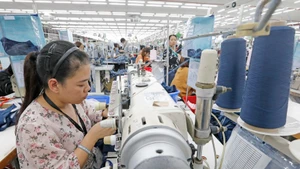When completed, these important traffic routes are expected to form a smooth connecting traffic corridor, creating new momentum to help the Southeast region promote its internal strength for development and create a more convenient gateway to connect with Central Highlands provinces.
In September 2024, Binh Duong Province inaugurated the North Tan Uyen-Phu Giao-Bau Bang road and Dong Nai 2 bridge. These two important traffic projects have helped connect industrial parks in Binh Duong Province and Binh Phuoc Province and make travel from the Central Highlands through Dong Nai to airports and seaports more convenient.
Additionally, the province is focusing resources on investing in key regional transport projects, such as Ring Road 3, Ring Road 4 of Ho Chi Minh City, and Ho Chi Minh City-Thu Dau Mot-Chon Thanh Expressway.
Proactively investing in transport connecting with localities
The Bac Tan Uyen-Phu Giao-Bau Bang dynamic road was inaugurated in September 2024 with a total length of nearly 48 km. The road passes through three localities in Binh Duong Province — namely the districts of Bac Tan Uyen, Phu Giao, and Bau Bang — with a 5km branch connecting from Phu Giao District to Dong Phu District in Binh Phuoc Province.
With a total investment of more than 5.2 trillion VND (of which compensation and site clearance costs account for over 1.53 trillion VND), the road has a scale of six lanes, a roadbed width of 40.5m, a design speed of 80 km/h. When put into use, it will open up new development space, connecting traffic between industrial-urban-service zones in the northern districts with the southern cities of Binh Duong Province and the region.
To facilitate the rapid implementation of the project, 851 households, individuals and 18 organisations within the project’s scope of influence have agreed and accompanied the authorities at all levels in the work of compensation, site clearance, resettlement, and are ready to relocate houses, works, architectural works, fruit trees, and crops to hand over 222 hectares of land. As a resident of Phu Giao District, Ho Van Loi, whose land is subject to clearance, shared that this route brings common benefits to the locality, to the people and promotes socio-economic development, so the people are very supportive.
Mai Hung Dung, Standing Vice Chairman of Binh Duong Provincial People’s Committee, said the Bac Tan Uyen-Phu Giao-Bau Bang route is one of the key traffic projects of the province. Once put into use, it will significantly shorten travel time, reduce transportation costs, meet the needs of trade, and improve the capacity of freight transport. It will also create new development momentum and space, connecting traffic between industrial-urban-service zones in the northern districts with the southern cities in Binh Duong Province as well as inter-regional connection with Binh Phuoc Province and the provinces of the Central Highlands through main traffic routes such as National Highway No.13, DH.614, DT.742, and National Highway No.14.
As such, it will help increase the attractiveness of Binh Duong Province and Binh Phuoc Province for domestic and foreign investors when choosing investment destinations, creating conditions for localities to continue to rapidly, comprehensively and sustainably develop in the coming time.
In September 2024, Binh Duong Province inaugurated Bach Dang 2 Bridge connecting Bach Dang Commune, Tan Uyen City (Binh Duong Province) and Binh Loi Commune, Vinh Cuu District (Dong Nai Province). Vo Tan Duc, Chairman of Dong Nai Provincial People’s Committee, shared that following the construction of Thu Bien Bridge, Binh Duong Province and Dong Nai Province agreed to build Bach Dang 2 Bridge to supplement the connection between the two provinces.
The funds for building Bach Dang 2 Bridge are contributed by the two localities, with each province contributing 50%. Bach Dang 2 Bridge connects the two sides, bringing people from both sides closer together while creating conditions for developing trade and transporting goods, while also contributing to the completion of the inter-provincial transport system in the Southern Key Economic Zone. At the same time, it opens more space for urban development, trade and services for the two provinces, as well as connects to key national transport routes, such as National Highway No.1, National Highway No.51, and expressways.
Accelerating the progress of key traffic projects
The consistent viewpoint of Binh Duong Province is that “Traffic infrastructure goes first to pave the way for development” and create momentum to promote socio-economic development. Immediately after the re-establishment of the province on January 1, 1997, in difficult conditions, the leaders of Binh Duong Province proposed a policy of socialising investment in traffic infrastructure.
Through investment in the form of BOT, the province assigned Becamex IDC Corporation to invest in expanding and upgrading National Highway No.13. The project is 62km long with six lanes connecting from Ho Chi Minh City to Binh Phuoc Province, connecting to National Highway No.14 (the current Ho Chi Minh Road through the Central Highlands) has created momentum to connect traffic between Binh Duong Province and the provinces of the Southeast and the Central Highlands.
From the success of National Highway No.13, other routes in Binh Duong continue to be formed through socialised resources, including Bau Bang-My Phuoc-Tan Van Road, contributing to awakening potential lands such as Ben Cat, Bau Bang, and Tan Uyen to strongly develop industrial parks and clusters, thus attracting effective investment.
According to the plan, 26 bridges will be built between Binh Duong Province and Ho Chi Minh City, Dong Nai, Tay Ninh; 12 bridges have been completed and the remaining bridges are being deployed. Currently, Binh Duong Province is focusing on accelerating the progress of starting, constructing, and inaugurating key traffic works connecting the region with a total investment of about 70 trillion VND (state budget capital allocated about 42 trillion VND; capital mobilised by investors in the form of public-private partnership (PPP) about 28 trillion VND.
For the Ho Chi Minh City Ring Road No.3 project, the section through Binh Duong Province, phase 1 includes Component Project No.5 (construction and installation) with four packages: Construction of Tan Van intersection, construction of Binh Chuan intersection, construction of the section from Binh Chuan to Saigon River, and construction of Binh Goi Bridge; as well as Component Project No.6 (compensation, support and resettlement).
According to the Department of Transport of Binh Duong Province, to date, the construction package of Binh Chuan intersection has reached 28.31%, the construction package of Binh Goi Bridge has reached more than 54%, the construction package of the section from Binh Chuan to Saigon River has reached 13.74% compared to the contract volume. The construction and installation packages have disbursed over 1.45 trillion VND, reaching 25.25% of the total investment of over 5.75 trillion VND.
For the Ho Chi Minh City Ring Road No.4, the section through Binh Duong Province is 47.5 km long. The grassroots appraisal council has completed the project appraisal, and the Binh Duong Department of Transport is coordinating with units and investors to propose adjustments to the 12 km urban road section to ensure national technical standards on expressways.
Regarding the Ho Chi Minh City-Thu Dau Mot-Chon Thanh Expressway through Binh Duong Province (about 52 km long), thus far Component Project No.1 (land clearance) and Component Project No.2 (construction and installation) have been approved by the Binh Duong Provincial People’s Committee. Regarding the BOT project to upgrade and expand about 13.8 km of National Highway 13 with an eight-lane scale from Vinh Binh Bridge bordering Ho Chi Minh City to the Le Hong Phong intersection in Thu Dau Mot City, Binh Duong Province is urgently accelerating the construction progress, striving to put it into use by April 30, 2025.
Vo Van Minh, Chairman of Binh Duong Provincial People’s Committee, said the province will continue to focus on investing in convenient traffic infrastructure to connect to the airport, port, and the centre of Ho Chi Minh City, such that human resources for people and businesses may travel to work conveniently.
Currently, the province is focusing on expanding and upgrading National Highway No.13, accelerating the progress of Ring Road No.3, deploying and preparing to start construction of Ring Road No.4 of Ho Chi Minh City and the Ho Chi Minh City-Thu Dau Mot-Chon Thanh Expressway, and connecting routes to Ho Chi Minh City and to the port.
The completion of these routes will open new connections for Binh Duong Province to key national traffic routes, contributing to the completion of the inter-regional traffic system; at the same time, opening up more space for urban, commercial and service development for localities, creating new momentum to promote green and sustainable socio-economic development.
















